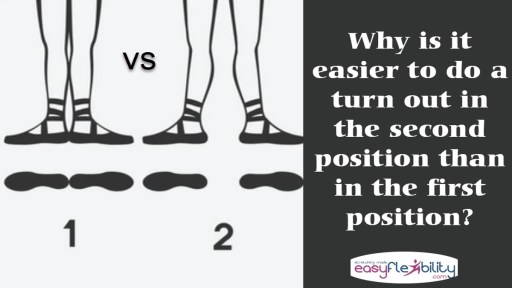
I got this question quite a lot of times, usually from bullet dancers “How come I can turn out a lot more in the second position, than I can in the first position?” For those of you who are not familiar with what these positions are but are still interested: The second position is where feet are wider apart. And the first position is where the feet are together.
The short answer is when you do the turn out with your feet together vs when you do the turn out with your feet apart, there are different muscles that need to be flexible. Of course, in the EasyFlexibility Turnout Program we focus on all the muscles that need to be flexible regardless of which position you are performing.
Ballet Turnout Strength & Flexibility Training At Home FROM EASIEST TO ADVANCED

This Ballet Turnout program will help you to be able to do a Turnout in Ballet, steadily, safely, painlessly and quickly with the use of the Proprietary Zaichik Stretching Techniques and Supporting Exercises.
- See visible results in 1 to 3 easy follow along workouts.
- Unique muscle by muscle isolation stretching techniques.
- Fast Progress.
- Permanent Results.
- No Pain.
- No Injuries.
- Flexibility & Strength combined.
- For all ages.
- 30 – 40 minute workouts, 2 – 3 times a week.
- All videos contain subtitles.
- Train at home. At your pace. From any device.
- Instant Access.
- No hidden fees. No strings attached. No surprises.
The muscles that are preventing you from doing a turnout are:
The muscles that want to turn in and thus prevent the turn out are your adductors: adductor longus, brevis, magnus, gracilis. Your hip flexor: Pectineus, Tensor Fascia Latter. And your abductors: Gluetus medius, gluteus minimus. The hamstrings also have a light effect on the rotation of the hip. But we can ignore them here because the hip is extended. If the hip was flexed, then the rotation factor would come into play.
So in short as your legs are wider apart your adductors and your pectineus, will need to be more and more flexible, for you to rotate out. And as your legs are closer together your gluteal group: Gluteus medius and gluteus minimus, as well as tensor fascia latte need to be more flexible. Tensor Fascia Latte, is a hip flexor, but it’s a funny hip flexor because It can also abduct. There are other hip flexors, that can abduct but they are not in the same group of preventing the external rotation with the feet together so we are not going to mention them.
Here is a reason why
What’s interesting is most people naturally have more flexible adductors and pectineus, then they do their abductors and tensor fascia latte. And for that reason as legs are wider apart most people will naturally have a better turn out as the legs are closer together, of course the muscles that are usually tight, have to be flexible. Most people don’t have this, so, the turn out will be worse when the legs are together or if the legs cross over with one leg being in front of the other.
Over the years people who use our programs have contacted us saying: “I got a perfect second position turn out very quickly, but while my first position has improved I don’t have 180 degree turn out what do I do?”
Well the beauty of Zaichik Stretching Techniques (ZST’s) is that the muscles can be isolated. With the ZST’s we can focus on the muscles that need to be flexible and will ignore the muscles that are already very flexible so the progress comes a lot faster.
With ZST’s you can isolate gluteus medius and minimus, and you can isolate tensor fascia latte. Once that is done, the progress comes very quickly and often people get a great first position turn out pretty quickly. While ZST’s stretch the muscle, the specialized supporting exercises help to retain the flexibility gained as well as build strength in the muscles.
Combining our proprietary ZST’s with the Supporting Exercises makes magic, and your flexibility gains increase tremendously fast. For more information about our Turnout Program please click here.
Ballet Turnout Strength & Flexibility Training At Home FROM EASIEST TO ADVANCED

It’s easy to get started!
If you are ready to start your Ballet Turnout training with a training method that is Easy, Pain Free and Fast, that is designed to work naturally with your body and keep your flexibility for years to come, then join thousands of satisfied EasyFlexibility practitioners and START YOUR TRAINING TODAY!
This Course includes the following step by step instructions for:
Ballet Turnout training program that will help you to train for turnout position, steadily, safely, painlessly and quickly with the use of the Proprietary Zaichik Stretching Techniques and Supporting Exercises.

